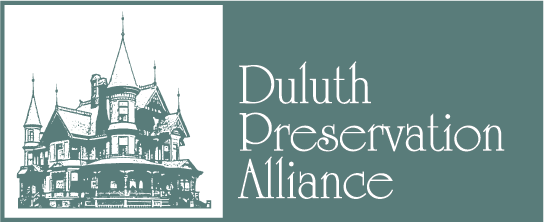When Jackie and David Bensman first took over the St. Mary’s Apartments on Third Avenue East in 2006, the police had a message for them.
“They told us, if nobody’s dead, don’t call,” Jackie recalls.
It might have been an offhand remark, but it encapsulated the trouble found here. There were more than 300 calls a year to the intersection of Third Avenue East and Third Street. The area was known as one of the most crime-ridden in downtown Duluth, police say. It was a far cry from the Benedictine home and school that was used from the turn of the century and through the 1960s in an area known for its churches and homes of the elite, once called Ashtabula Heights.
Today, there are only a couple of calls. Most of the tenants at St. Mary’s have turned over. With each transition, the couple went in and refurbished the apartments, once home to the School of Nursing run by nearby St. Mary’s Hospital. Before that, and even more historically, the 1894 building was built for the nuns who eventually created the College of St. Scholastica.
The Bensmans’ restorations, along with the change in the neighborhood, is what the Duluth Preservation Alliance mentioned this spring in giving them an award for their efforts.
“We didn’t want to lower our standards,” Jackie said. They stood their ground with the tenants and in six months, things started turning a corner, she said. Drug busts added to the cleanup, the couple said.
Gayle Holton, the East Community Policing Sergeant for the Duluth Police Department, said Third and Third was a “very busy corner” between the St. Mary’s tenants and those across the avenue in another multi-unit building.
He credited remodeling and upgrading the area by new building owners like the Bensmans — new lighting, self-policing and cameras — for changing things.
The couple hasn’t stopped at the 36 units in the St. Mary’s buildings, built in 1898 and 1933. They’ve taken on duplexes and triplexes just up the hill on Fifth Street — nine more units.
They’ve taken ownership of the neighborhood, David said. If they see a dilapidated building — and it’s mostly intact with original materials — they’ll take it on.
“Abused, abused, abused,” David said of the 1891 duplex on Fifth. “It was nasty.”
But the original woodwork and hardware was there, along with plaster, despite some major cracks.
They don’t replace things with cheap materials. They fix what they can and then “try to keep everything solid,” David said. He will not install Formica counters, for instance, insisting on stone.
It’s akin to what they’re trying to do in the neighborhood, which still has its share of criminal activity, he said. They don’t want to Band-Aid things, they want a permanent transformation.
They are clustering their restorations to keep maintenance easier. “I’m trying to stay local,” David said. “I keep the snow blower going to the next property, the lawn mower.”
He mows the boulevard up Third Avenue to the triplexes and duplexes. He doesn’t have to, but it’s part of his commitment to keeping the area in shape, he said.
An irony exists in that the expansion of the St. Mary’s Hospital (now Essentia) campus — such as the school and dormitories and, today, parking lots — is often cited as the reason this part of Central Hillside has become so disjointed and the homes so dilapidated. The old feeling of community is gone, David said.
The St. Mary’s complex became a home for older nuns after St. Mary’s moved out in the 1940s. It was converted into apartments in the early 1970s.
“The building was gorgeous, and the price was right,” David said of the decision to move to Duluth in 2006 and take it on.
The couple arrived here like so many people. They would travel through from the Twin Cities area on their way to the Boundary Waters Canoe Area Wilderness. David had been managing apartments and wanted to take the leap into ownership.
“I love it,” Jackie said of Duluth. “It took me about a year to slow down.” She said she had been one of those people with a Blackberry permanently stuck to her ear. The pace of things here sometimes “just agitated me.”
“People actually look you in the eye here,” Jackie said with a laugh.
They lived in a camper on the St. Louis River the first summer while whipping the apartments into shape.
There hasn’t been any borrowing or public grants used in the purchases and restorations, David said. “Credit cards and us — I’m proud of that.”
It’s a solid set of buildings, David said, and maintenance hasn’t been difficult. And they’ve been innovative. Solar panels on the roof power hallway lights, dryers and pumps. A new heating plant keeps things energy-efficient.
There are just two original tenants at St. Mary’s. Their renters include 20-somethings, young professional and health care workers. It’s a nice mix, Jackie said.
David would like to see the area gain some sort of historic status in order to stem the destruction of old homes and create some community pride. According to a city study completed in 2014, the St. Mary’s buildings, with the connection to Scholastica, likely qualify for formal historic status.
Jackie said she’s traveled to many places across the world and knows the Hillside area can be turned around. It just takes a full effort, she said.
“I’ve seen it. It gives me hope,” she said.
“I hope Duluth realizes it has an asset here,” David said.
They appreciate the recognition from the preservation alliance, although they don’t consider themselves historic restorers. They’re doing it for their neighborhood.
“This isn’t just to show-off,” Jackie said. “It surprised us that people noticed.”
http://www.duluthnewstribune.com/features/home/3774989-home-histories-restoring-st-marys-buildings-central-hillside
